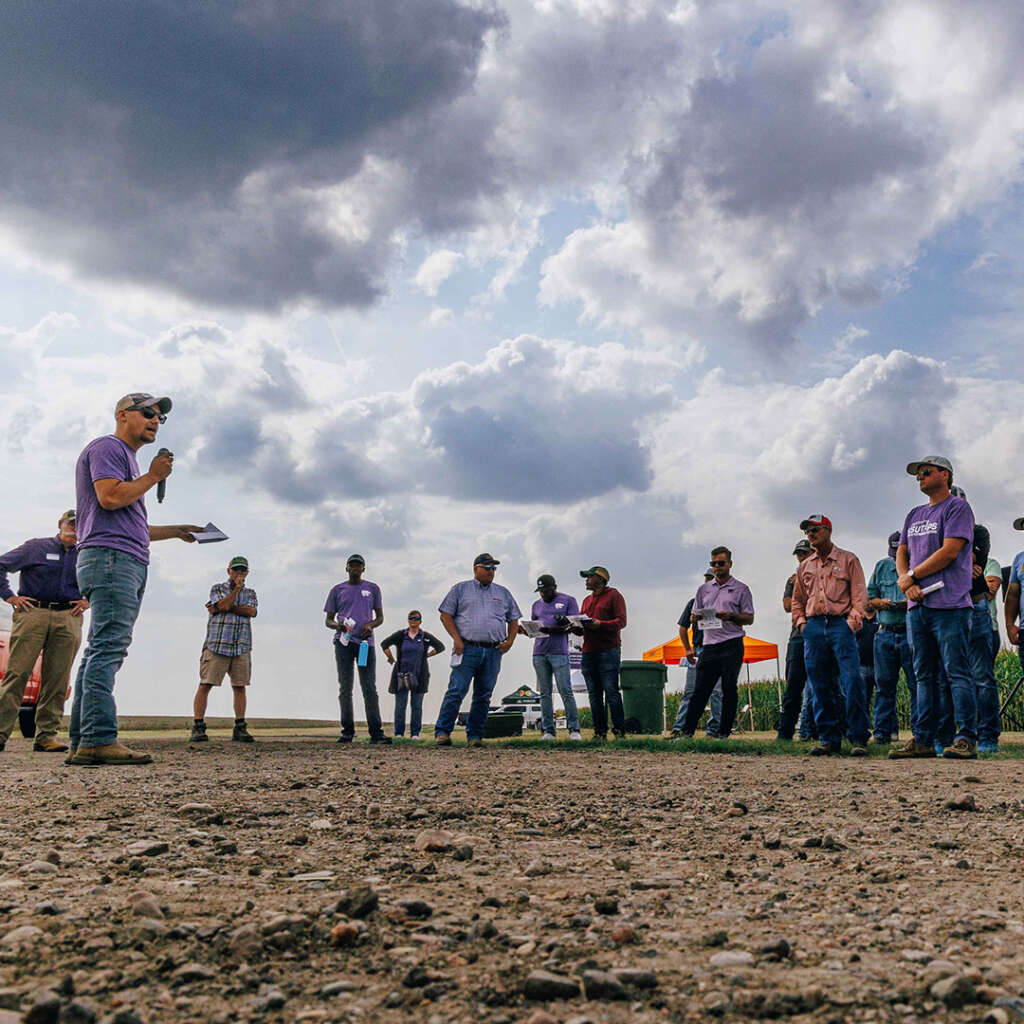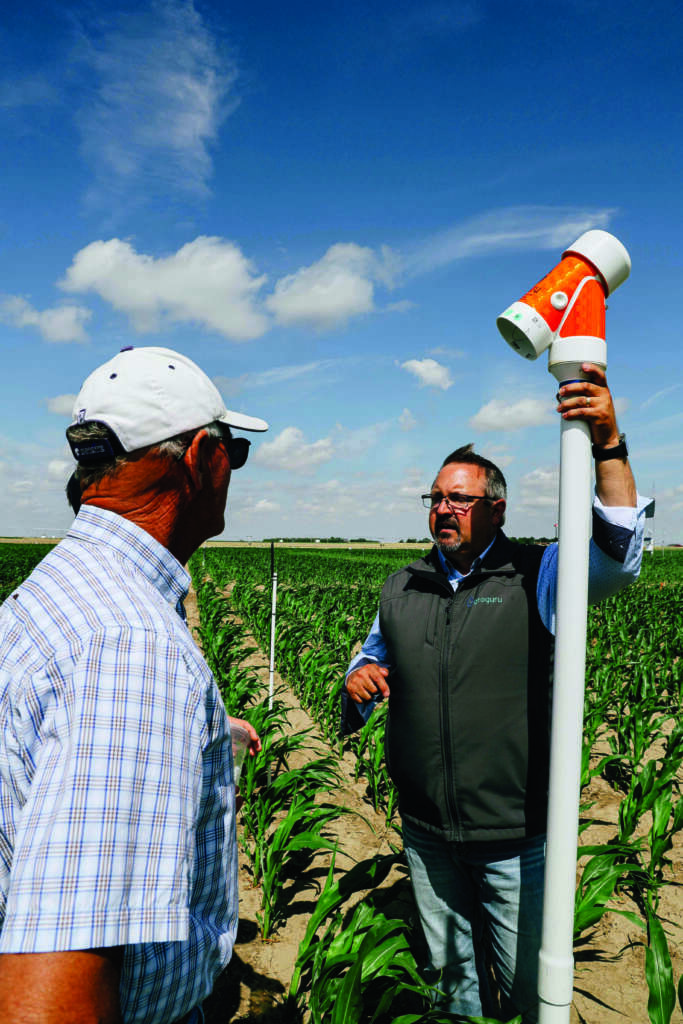Kansas farmers compete for bragging rights in a competition led by K-State scientists
Seeds, fertilizer, herbicide and water are the essential ingredients for farming. But figuring out the magic recipe of seed genetics and the amounts and timing of the ingredients is part science and part educated guess.
Farmers are constantly monitoring, analyzing and making decisions to predict what will produce the best outcome. Trying something new could be risky to the bottom line.
But what if the personal risk was removed? That’s where TAPS comes in.
Kansas State University’s Testing Ag Performance Solutions (TAPS) competition provided testing plots for farmers to experiment and learn what works best — and compete for bragging rights.

THE PROOF IS IN THE PLOT
K-State’s competition is an artificial framework, but it has real-world implications.
The 2024 competition took place in Colby, Kansas, at the Western Kansas Research-Extension Center where 34 teams each got four randomized plots in a 12-acre area. What’s great about TAPS is competitors can bet on new approaches without having to bet the family farm.
“At the research center here, we can do things in a highly controlled environment, yet we know that we’re not necessarily completely addressing the complexity and the style of farming,” explained Daran Rudnick, director of sustainable irrigation at K-State. “So we came up with the idea of bringing people together at the research site to inform our research through a competition environment utilizing equipment to do variable-rate irrigation, precision planting and variable-rate nutrient management.”
Commercial partners give each team access to all the latest technology: soil moisture monitoring, plant sensing and drone aerial imaging. The K-State Research and Extension TAPS team at the testing field collects soil samples for the teams and sends data from their plots. Then the TAPS staff implement each team’s farming decisions.
“That’s the beauty of this competition,” said Russ Martin from Oakley, Kansas. “You get to try splitting out fertilizer at different rates and times and irrigating with different water amounts, which I can’t do with my personal fields. Then we have the end-of-year meeting to see how everything stacks up. This is a great chance to learn something at no cost.”
Martin’s team was the most economically profitable under Q-stable water-pumping levels.

EXPLORING HOW THE OTHER HALF FARMS
The 2024 TAPS competition used tilled plots. For many no-till farmers, this was a chance to see firsthand the difference between the two farming methods.
Abby Kroupa is the third generation to farm her family’s fields in Mingo, Kansas, just outside Colby. They’ve been a no-till farm for 30 years. Her father switched to that method of farming to conserve water and improve soil health.
“We’re in our fields every week, utilizing soil tech — probes and satellite imagery — watching what’s going on,” Kroupa said. “That way we know exactly how much water we’re applying and where we stand so that we meet what the fields need without over applying.”
The difference between Kroupa’s no-till fields and the tilled TAPS competition field was stark.
“The evapotranspiration differences I’m noticing coming out of this test plot versus what I’ve got at my farm just two miles down the road — the soil temperatures are getting hotter than my soils ever get, impeding water and nutrient uptake,” she said. “It really solidifies the value no-till provides to the soil.”
The 2024 competition plots needed to be tilled to remove remnants of past research. Going forward, the competition will incorporate best practices like no-till and cover crops.

PROTECTING THE PLAINS
Water levels in the High Plains aquifer fell about a foot last year, according to the Kansas Geological Survey. Western and south-central Kansas rely on the aquifer for everything from drinking to irrigation.
The High Plains aquifer is a network of water-bearing rock that extends into eight states. In Kansas, the aquifer consists of three components — the Ogallala aquifer, the Great Bend Prairie aquifer and the Equus Beds. The Ogallala lies under most of western Kansas and supplies water for the western third of the state.
The Ogallala has been in decline since the mid-20th century. After World War II, an acceleration in groundwater irrigation transformed the arid plains into verdant fields of corn, wheat, sorghum and soybeans. But the aquifer isn’t able to refill faster than farmers and communities drain it, leading to a gradual decline in its levels.
“Protecting the aquifer is a really big issue, especially now that I’ve got a daughter,” Kroupa said. “We’re trying to keep our farming operation around, not just for myself and my husband, but for the success of my daughter and future generations. It’s a big deal to try not to pump it all out.”
Farmers don’t have to stop pumping groundwater to irrigate crops altogether. The KGS estimates that on average, if farmers reduce pumping by 17.5%, that will stabilize the supply.
“Everybody recognizes that water, whether it’s given to us through rainfall or if we use irrigation, is the lifeblood of agriculture,” Rudnick said. “We’re looking at different aspects of how to work within this irrigated environment, whether that’s a hybrid seed selection or fertility optimization. Those decisions drive the economics and profitability of farming. TAPS brings in all the complexity of farming with an effort to optimize a limited resource: water.”

LESSONS LEARNED
Not only were teams challenged to reduce irrigation, they had to do it in a drought year. Colby only received 8.35 inches of rain — just 63% of the norm.
So how did the 34 teams do?
Organizers used the Water-Nitrogen Intensification Performance Index (WNIPI) to track how well a crop converts additional water and nitrogen into yield gains.
When compared to a non-irrigated control, the irrigated TAPS fields scored between -0.012 and 0.346. Lower scores indicate inefficiency, while higher scores show better resource use.
The team with the highest input use efficiency — Garret Smith, Mike Barton, Kel Grafel and Nick Higgason of Barton County — achieved top marks by timing irrigation based on soil moisture data and crop development. The team paired its water and nitrogen applications, “spoon feeding” the crop through the growing season. The method proved most efficient in reducing environmental impact while optimizing crop performance.
“Efficiency isn’t just about cutting back on water and fertilizer. It’s about maximizing what you apply,” Higgason said. “With our aquifer struggling, we must be as efficient and sustainable as possible. Sustainability means being progressive and profitable, not just chasing yield.”
Their results highlight the delicate dance of balancing resources with crop needs. As water reserves decline, farmers will be forced to adopt the most efficient irrigation practices. Farmers who learn to do more with less will be the ones who thrive. The only way to win is to play the long game.
2024 TAPS BY THE NUMBERS
- 34 Teams
- 12 Acres per team
- 170 Average bushels per acre across all farms
- 238 Highest bushel per acre
DID YOU KNOW?
In an average TAPS competition, there are more than a quindecillion possible decision scenarios.
What’s a quindecillion? 1, followed by 48 zeroes.


